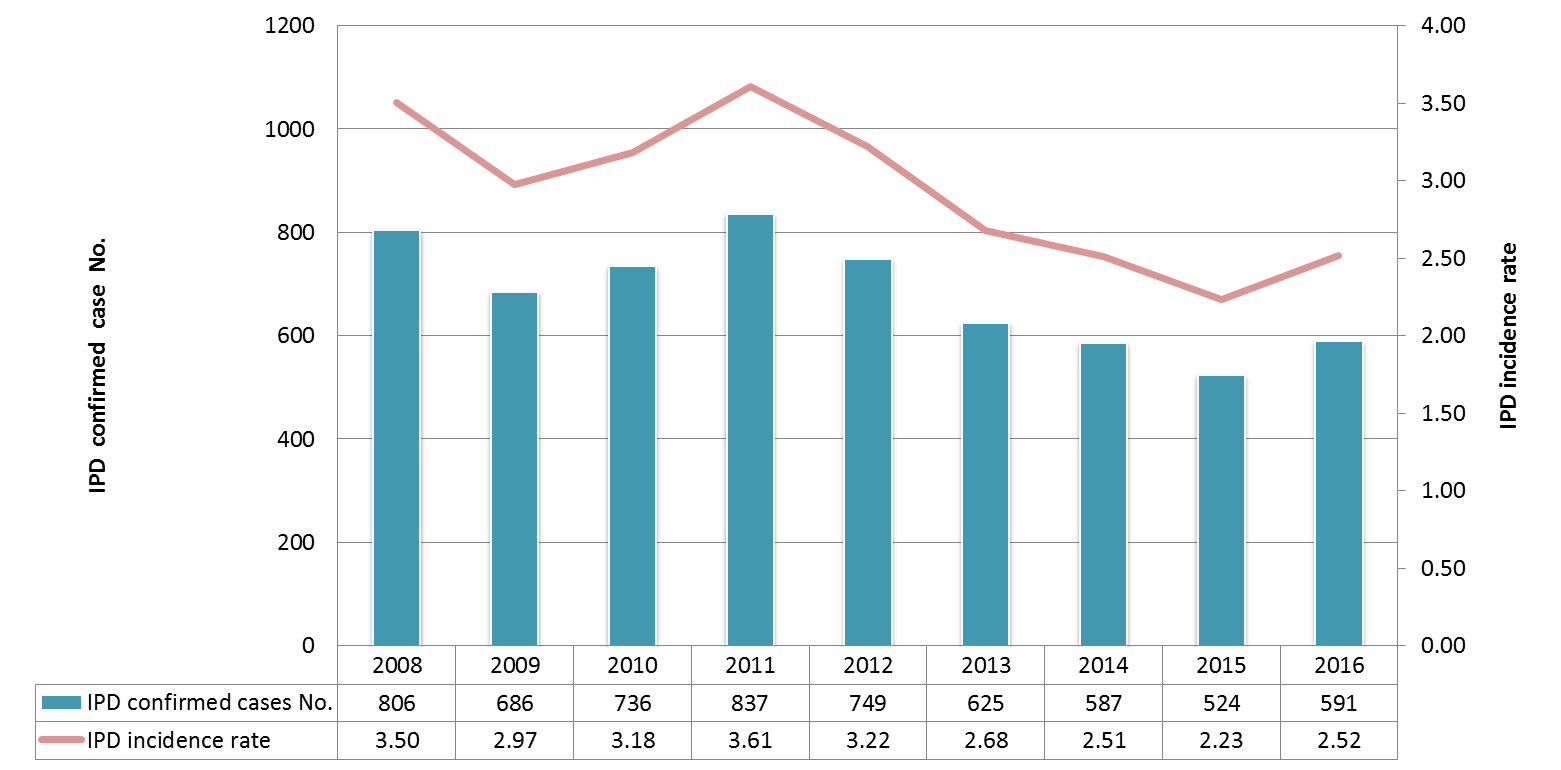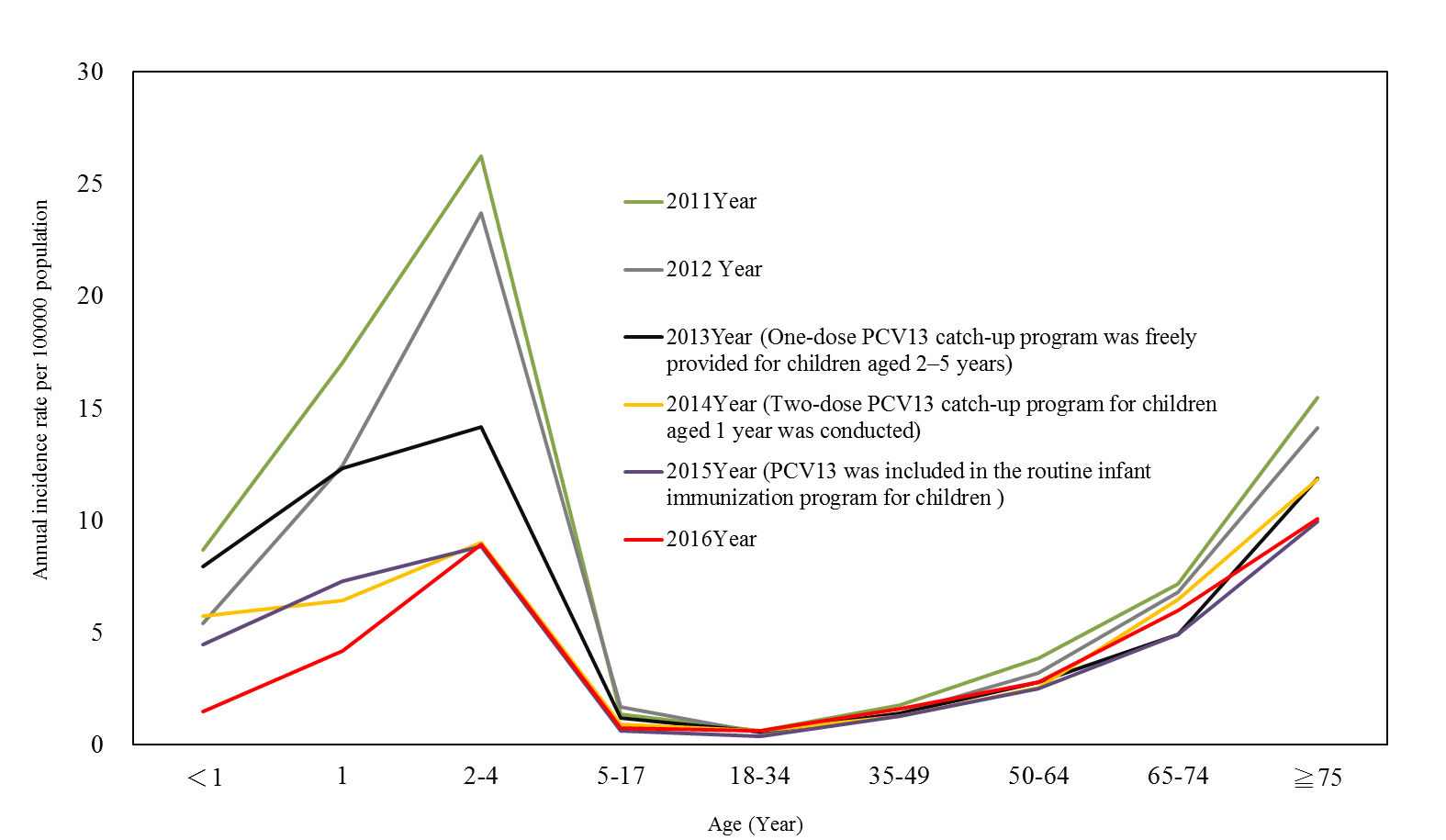Invasive Pneumococcal Disease
Background
Pneumococcal disease is an infection caused by the Streptococcus pneumoniae, also known as pneumococcus.
Pneumococci are very common. These bacteria spread from person-to-person by direct contact with respiratory secretions, like saliva or mucus. Many people, especially children, have the bacteria in their nose or throat at one time or another without being ill. This is called “carriage”.
Streptococcus pneumoniae is a type of bacteria that can cause infections of the ears, sinuses or lungs. It can also cause more serious infections of the blood or brain. This type of infection is called invasive pneumococcal disease (IPD). Infection can result in pneumonia, bacteremia, sepsis, or bacterial meningitis.
Anyone can get pneumococcal disease, but some people are at greater risk for disease than others. Being a certain age or having some medical conditions can put you at increased risk for pneumococcal disease. It particularly affects the very young, the elderly, people with no spleen or a non-functioning spleen, people with other causes of impaired immunity and chronic medical conditions.?
There are more than 92 different pneumococcal types (serotypes) that can cause disease in humans. Each year, approximately 600 cases of IPD are reported in Taiwan. And that is most common in the younger under age 5 and the elder over age 65. The number of cases peaks in December and January.
Many bacteria, including some Streptococcus pneumoniae (pneumococcus), have become resistant to one or many antibiotics. Resistance can lead to treatment failures. When this happens, it is harder to treat the infection. For this reason, prevention is very important. The best way to prevent IPD infection is by getting a pneumococcal vaccine.
IPD Surveillance in Taiwan?
Taiwan National Infectious Disease Statistics System Invasive pneumococcal disease
1. Incidence of IPD by year
In recent years, approximately 520-800 people contract Invasive pneumococcal disease(IPD) annually in Taiwan.
The annual incidence of IPD?per 100,000 populations has varied between 2.23 to 3.61(Fig1), which mainly affected children under 5 years of age and the elder over 65 years of age(Fig2). The number of cases peaks in the Winter and the Spring.

Fig1.The Annual confirmed cases and incidence rate of IPD in Taiwan,2008-2016
2. Age-specific Incidence of IPD by year
Fig2 present domestic age-specific incidence of IPD from 2011 through 2016.Since PCV13 had been approved and replaced PCV7 to use for child in 2011 ,the incidence of IPD dramatically decreased in the younger under 5 years of age, especially in infant aged 2 to 4 years. We have observed the broad-scale use of PCV13 in young children have provided considerable benefit, the effect of infant PCV13 immunization program provided indirect protection for the elderly over 65 years of age ,that’s so-called “herd immunity”.

Fig2 Age-specific incidence of IPD in Taiwan,2011-2016.
Prevention and Control
1. VaccinationThe most important way to prevent invasive pneumococcal disease (IPD) is to get?vaccinated. Two different pneumococcal vaccines are available in the market in Taiwan now, including the pneumococcal conjugate vaccine (PCV13) and the 23-valent pneumococcal polysaccharide vaccine (PPV23). Both of them are inactivated vaccines (or killed vaccines).While giving several?vaccinations?at the same, must be injected separately at different site.
PCV13 contains polysaccharides of the capsular antigens of Streptococcus pneumoniae serotypes 1, 3, 4, 5, 6A, 6B, 7F, 9V, 14, 18C, 19A, 19F, and 23F. It can protects children and adults against most of the severe illness caused by serotypes unique to PPSV13, and PPV23 covers 10 additional serotypes compared to PCV13 (2, 8, 10A, 11A, 12F, 15B, 17F, 20, 22F, and 33F) types of pneumococcal bacteria. Broader protection is expected to be provided through use of both PCV13 and PPSV23 in series.
National Pneumococcal immunization programs and recommendation in Taiwan:
( 1 ) PCV13
(1)-1.PCV13 was introduced to the national children routine immunization program using the 2+1 schedule in January 2015, providing healthy infants with 2 primary doses given 2 months apart, starting at 2 months of age, followed by a booster dose at 12-15 months. The children with underlying diseases are immunized with the PCV13 using the 3+1 schedule ,including those with splenectomy or spleen functional impairment; those with congenital immunodeficiency or human immunodeficiency virus infection; those with cochlear prosthetic devices or electromagnetic hearing devices; those with chronic kidney disease, severe congenital heart disease, chronic pulmonary disease, or diabetes; those with spina bifida or other clinical conditions that result in cerebral spinal fluid leakage, and those with malignancy or who have received organ transplantation.
(1)-2. PCV13 is also recommended for people 2-64 years old at high risk for disease and all adults 65 years or older. If persons in the high-risk groups have any needs, should consult doctors on having the vaccination for protection, or call the toll-free Communicable Disease Reporting and Consultation Hotline, 1922 (or 0800-001922).
( 2 ) PPV23:With the financial support from a non-government organization, PPV23 has been provided to the elderly aged ≥75 years in Taiwan since 2007. According to recommendations by Taiwan Advisory Committee on Immunization Practices (ACIP),PPV23 is recommended for those 2 years or older at high risk for disease and all adults 65 years or older. The number of doses required will depend on the age when the first dose is given and clinical condition. People should consult with doctors on the most appropriate vaccination regimen, or call the toll-free Communicable Disease Reporting and Consultation Hotline, 1922 (or 0800-001922).
2. Treatment
People infected with pneumococcal need to take antibiotics to get better. In some cases, even with antibiotics, the bacteria can cause permanent damage. As antimicrobial resistance develops, cases of IPD are becoming harder to treat with antibiotics. Preventing IPD with the pneumococcal vaccine is very important.
3. Hygiene practices
- ( 1 )Cover your mouth and/or nose with tissue paper when coughing or sneezing.
- ( 2 ) Avoid visiting crowded or poorly ventilated public places if feeling unwell.
- ( 3 ) Keep hands clean and wash hands properly.
- ( 4 )Dispose of soiled tissues properly into a rubbish bin with lid, and then wash hands thoroughly.
- ( 5 ) Put on a surgical mask when having respiratory symptoms ,and see a doctor straight away
FAQs
- What is pneumococcal infection?
- Pneumococcal infection represents a wide range of diseases caused by Streptococcus pneumoniae. While pneumococcus is a common cause of mild illnesses such as sinus or middle ear infections, it may also cause severe or even life-threatening IPD such as pneumonia, sepsis, and meningitis. The outcomes for IPD are usually more severe among young children and elderly persons.
- How does individual acquire pneumococcal infections?
- Pneumococci are present in the respiratory tracts even in some healthy carriers. They exist commonly in the nose and throat of healthy people, particularly in children. The bacteria can be transmitted via spread of droplet, direct oral contact or indirect contact with articles soiled with respiratory discharges.
- Can pneumococcal vaccines be received together with other vaccine?
- Yes. Both PPV23 and PCV13 can be given together with other vaccines, including influenza vaccine, but they should be administered at different injection site.
More Information
Images


